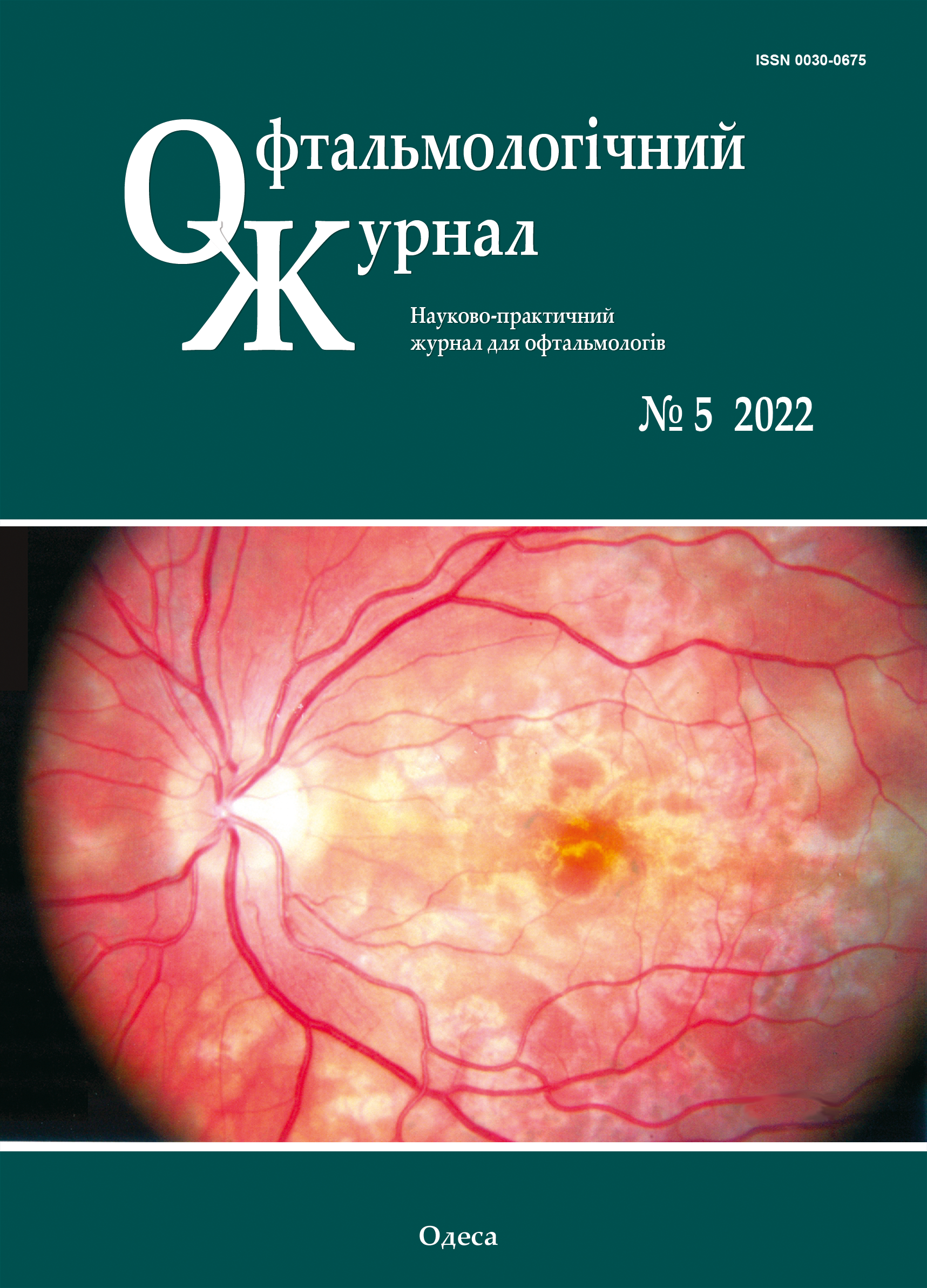Using a liposomal ozone-based solution in comprehensive treatment of bacterial keratitis
DOI:
https://doi.org/10.31288/oftalmolzh202251922Keywords:
bacterial keratitis, liposomal ozone-based solution, comprehensive treatment, clinical scoresAbstract
Background: Keratitis is an inflammatory eye disease frequently leading to complications, significantly decreased vision and visual disability. Common infectious agents include, in particular, aggressive Gram-negative microflora and opportunistic bacteria. The use of conventional antibacterial therapy does not guarantee a positive treatment effect. Infections caused by antibiotic-resistant germs frequently result in increased hospitalization rates with an increased length of inpatient stay at hospital and can cause severe corneal opacities. Formation of biofilms is a cause of increased antibiotic resistance.
Purpose: To improve the efficacy of treatment of bacterial keratitis by integrating an adjunctive liposomal ozone-based solution into comprehensive treatment.
Material and Methods: Forty-four patients (44 eyes) with bacterial keratitis, aged from 29 to 75 years, were involved in the study. Patients were divided into an ozone group of 21 patients and a control group of 23 patients. All patients were administered antibacterial therapy, mydriatics, desensibilizing agents, tissue preparations and vitamins. In addition, patients of the ozone group received an eye drop of ozone-based solution four times a day for 10 days.
Results: The method allowed for a significant (р < 0.001) reduction in conjunctival discharge, mixed conjunctival injection, corneal edema and inflammatory response, leeading to a 3.3 ± 0.1 day reduction in the length of inpatient stay at the hospital.
Conclusion: Utilizing a liposomal ozone-based solution as an adjunct to the comprehensive treatment of bacterial keratitis is a novel treatment method making it possible to accelerate corneal epithelization and reduction in inflammation, and to shorten the length of treatment.
References
1.Laboratory findings in tear fluid analysis. Ohashi Y, Dogru M, Tsubota K. Clin Chim Acta. 2006 Jul 15;369(1):17-28. https://doi.org/10.1016/j.cca.2005.12.035
2.Miller D. Update on the epidemiology and antibiotic resistance of ocular infections. Middle East Afri J Ophthalmol. 2017;24(1):30-42. doi: 10.4103/meajo.MEAJO_276_16. https://doi.org/10.4103/meajo.MEAJO_276_16
3.Ventola CL. The antibiotic resistance crisis: part 1: causes and threats. PT. 2015;40: 277-283.
4.Ting DSJ, Ho CS, Cairns J, et al. 12-year analysis of incidence, microbiological profiles and in vitro antimicrobial susceptibility of infectious keratitis: the Nottingham Infectious Keratitis Study. Br J Ophthalmol. 2021. 105 (3): 328-333. https://doi.org/10.1136/bjophthalmol-2020-316128
5.Smith NL, Wilson AL, Gandhi J, et al. Ozone therapy: an overview of pharmacodynamics, current research, and clinical utility. Med Gas Res. 2017; 7(3):212-219. https://doi.org/10.4103/2045-9912.215752
6.Spadea L, Tonti E, Spaterna A, Marchegiani A. Use of ozone-based eye drops: a series of cases in veterinary and human spontaneous ocular pathologies. Case Rep Ophthalmol. 2018;9: 287-298. https://doi.org/10.1159/000488846
7.Cagini C, Mariniello M, Messina M, et al. The role of ozonized oil and a combination of tobramycin/dexamethasone eye drops in the treatment of viral conjunctivitis: a randomized clinical trial. Int Ophthalmol. 2020;40(12):3209-3215. https://doi.org/10.1007/s10792-020-01503-4
8.Celenza G, Iorio R, Cracchiolo S, et al. Antimycotic activity of ozonized oil in liposome eye drops against Candida spp. Transl Vis Sci Technol. 2020;9:4. https://doi.org/10.1167/tvst.9.8.4
9.Kim HS, Noh SU, Han YW, et al. Therapeutic effects of topical application of ozone on acute cutaneous wound healing. J Korean Med Sci. 2009;24(3):368-374. https://doi.org/10.3346/jkms.2009.24.3.368
10.Patel PV, Gujjari SK. The Morphometrical and Histopathological Changes which were Observed after Topical Ozone Therapy on an Exophytic Fibrous Gingival Lesion: A Case Report. J Clin Diagnostic Res. 2013 Jun;7(6):1239-43. https://doi.org/10.7860/JCDR/2013/4963.3039
Downloads
Published
How to Cite
Issue
Section
License
Copyright (c) 2025 В. М. Сакович, О. В. Алексєєва

This work is licensed under a Creative Commons Attribution 4.0 International License.
This work is licensed under a Creative Commons Attribution 4.0 International (CC BY 4.0) that allows users to read, download, copy, distribute, print, search, or link to the full texts of the articles, or use them for any other lawful purpose, without asking prior permission from the publisher or the author as long as they cite the source.
COPYRIGHT NOTICE
Authors who publish in this journal agree to the following terms:
- Authors hold copyright immediately after publication of their works and retain publishing rights without any restrictions.
- The copyright commencement date complies the publication date of the issue, where the article is included in.
DEPOSIT POLICY
- Authors are permitted and encouraged to post their work online (e.g., in institutional repositories or on their website) during the editorial process, as it can lead to productive exchanges, as well as earlier and greater citation of published work.
- Authors are able to enter into separate, additional contractual arrangements for the non-exclusive distribution of the journal's published version of the work with an acknowledgement of its initial publication in this journal.
- Post-print (post-refereeing manuscript version) and publisher's PDF-version self-archiving is allowed.
- Archiving the pre-print (pre-refereeing manuscript version) not allowed.












